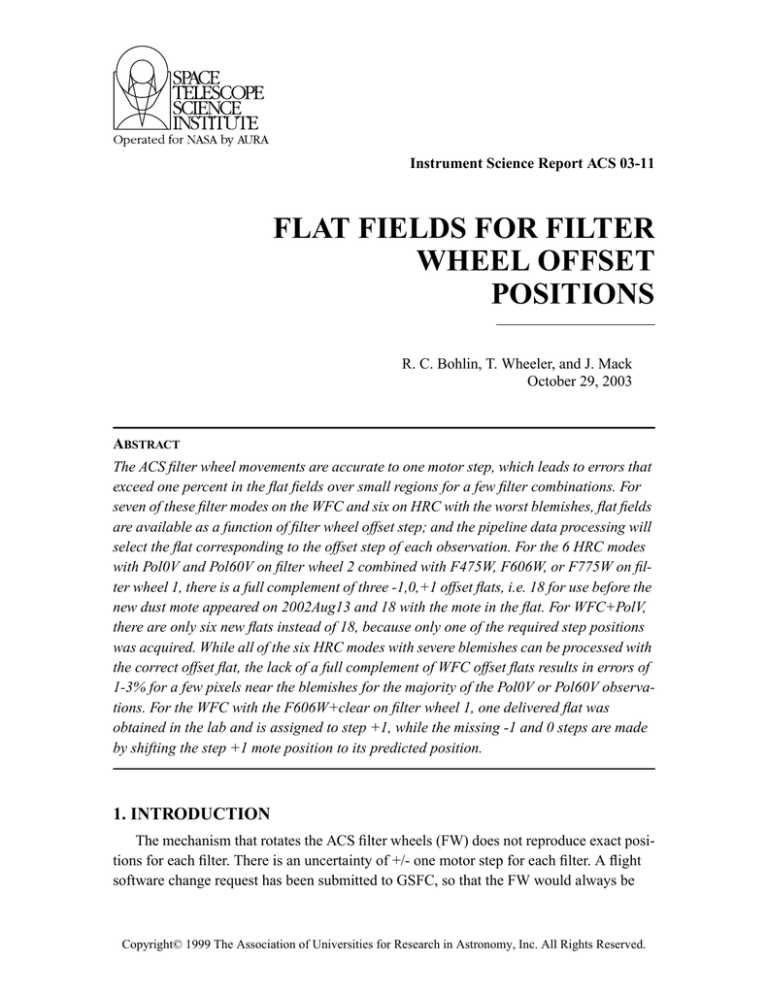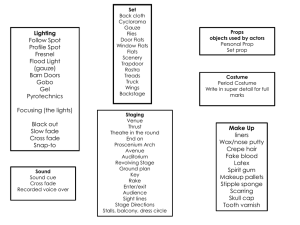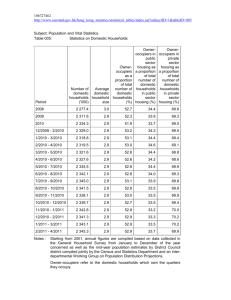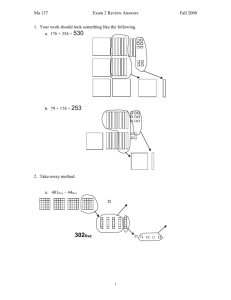
Instrument Science Report ACS 03-11
FLAT FIELDS FOR FILTER
WHEEL OFFSET
POSITIONS
R. C. Bohlin, T. Wheeler, and J. Mack
October 29, 2003
ABSTRACT
The ACS filter wheel movements are accurate to one motor step, which leads to errors that
exceed one percent in the flat fields over small regions for a few filter combinations. For
seven of these filter modes on the WFC and six on HRC with the worst blemishes, flat fields
are available as a function of filter wheel offset step; and the pipeline data processing will
select the flat corresponding to the offset step of each observation. For the 6 HRC modes
with Pol0V and Pol60V on filter wheel 2 combined with F475W, F606W, or F775W on filter wheel 1, there is a full complement of three -1,0,+1 offset flats, i.e. 18 for use before the
new dust mote appeared on 2002Aug13 and 18 with the mote in the flat. For WFC+PolV,
there are only six new flats instead of 18, because only one of the required step positions
was acquired. While all of the six HRC modes with severe blemishes can be processed with
the correct offset flat, the lack of a full complement of WFC offset flats results in errors of
1-3% for a few pixels near the blemishes for the majority of the Pol0V or Pol60V observations. For the WFC with the F606W+clear on filter wheel 1, one delivered flat was
obtained in the lab and is assigned to step +1, while the missing -1 and 0 steps are made
by shifting the step +1 mote position to its predicted position.
1. INTRODUCTION
The mechanism that rotates the ACS filter wheels (FW) does not reproduce exact positions for each filter. There is an uncertainty of +/- one motor step for each filter. A flight
software change request has been submitted to GSFC, so that the FW would always be
Copyright© 1999 The Association of Universities for Research in Astronomy, Inc. All Rights Reserved.
Instrument Science Report ACS 03-11
placed at the 0 step position; but the flight software has not yet been updated. Because the
filters are located near the detectors in a converging light beam, imperfections on the filters
produce an out of focus image at the detector. For most filters, any imperfections are
minor; and the one step positioning offsets cause <1% errors in the flat fielding of data
images. However, three filters have severe blemishes that cause >1% errors in small
regions of the flat fielded images for a one step error in filter wheel position (Bohlin &
Hartig 2002). These filters are F606W, Pol0V, and Pol60V for which the primary motes
are indicated with an arrow in Figure 1.
This problem was recognized and addressed before launch by a laboratory calibration
campaign to get flat fields at the nominal position (0), at plus one step (+1), and at minus
one step (-1) for F606W+clear on WFC and for the two PolV filters in combination with
the high priority F475W, F606W, and F775W filters on both HRC and WFC.
The blemish misregistration is an error in the pixel-to-pixel high frequency P-flat component of the flat fields and is not related to the low frequency L-flat correction, which has
been applied for all the standard and polarizing filters (Mack, et al. 2003).
2. MECHANISM REPEATABILITY
There is enough information in the ACS engineering telemetry to determine the exact
step position of the filter wheels from the commanded positions and the resulting motor
commutation (Flight Software Change Request scrj313-New Algorithm to Correctly Position Filter Wheels by T. Wheeler). The statistics since launch for the resulting step
positions are summarized in Table 1 for the three filters with the worst blemishes.
Table 1. Table 1. Filter Wheel Positioning Statistics for 02Mar-03Jul
Filter
Camera
No. of Obs.
Step -1
(%)
Step 0
(%)
Step +1
(%)
Other Step
(%)
Pol0V on FW2
HRC
36
17
81
3
0
Pol60V on FW2
HRC
36
44
53
0
3
F606W on FW1
WFC
552
5
94
1
0
Pol0V on FW2
WFC
29
17
76
0
7
Pol60V on FW2
WFC
29
55
45
0
0
3. THE FLAT FIELDS FOR PIPELINE DATA PROCESSING
The production of pipeline flats from the lab data is complicated, because all the commanded laboratory motor positions were off by one or two steps, and because there is an
on-orbit gravity release shift between the filter wheel positions and the detectors. The
gravity release shift (see Section 4) is on the order of one filter wheel step for the PolV fil-
2
Instrument Science Report ACS 03-11
ters on FW2. In the case of HRC, the gravity release compensated the lab shift error, while
for WFC+PolV the gravity release exacerbated the lab step positioning errors so that only
a few of the required offset flats are available. For the WFC flats with the small PolV filters, either chip can be used, so that there are 2 sets of flats for each of the six filter
combinations for a total of 36 stepped PolV flat fields measured in the lab. For this total of
12 sets of -1,0,+1 flats, the position of FW2 was off by one step in the -1 direction in 10
cases, so that the positions sampled are -2,-1,0, instead of the intended -1,0,+1. Two WFC
cases: F475W+Pol60V on chip 1 and F775W+Pol0V on chip 2 are off by two steps from
the intended positions. For HRC, attempts to place the PolV filters at the nominal 0 step
position were off by the same -1 step as the WFC PolV flats in all six cases.
Because errors of two steps are rare and cannot be detected by the algorithm, only flats
for -1,0,+1 positions are delivered as reference files. Table 2 summarizes the available
flats, where column 3 lists the actual filter wheel step obtained in the lab, and column 4
gives the assigned step of these lab flats after compensating for the gravity release shift of
+1 step for HRC PolV on FW2, -1 step for WFC PolV on FW2, and +1 step for WFC
F606W on FW1. The last column lists the fractional occurrence covered by the available
flats using the frequency of occurrence of each step position from Table 1. For the two
WFC cases with indeterminate step positioning, the most likely step position error is -2
steps, so that the intended +1 step is really the -1 step. As a best guess, these two cases are
indicated by -1? in column 3 of Table 2. For these chip 1 F475W+Pol60V and chip 2
F775W+Pol0V modes with only -1 flats, the gravity release shift of an added step means
that none of the required flats are available and that there will always be errors of more
that 1% in the pipeline products of these two WFC modes.
When the FW position is indeterminate or at a position with no available flat, the 0
position flat is used, except for the WFC+PolV cases with only -1 flats that must be used
for all observations. The data header keyword FWOFFSET indicates the position of the
flat used by the pipeline processing. The default population for all observations is 0 for
FWOFFSET and F (false) for its companion FWERROR. If flat field reference files are
available for any step other than 0, then the value of FWOFFSET can change to -1 or +1 to
reflect the selection of the correct offset flat. If flat field reference files are available for any
step other than 0 and the correct FW offset cannot be determined from the engineering
telemetry, then FWERROR is set to T (true), FWOFFSET is 2, and the 0 step flat is used
to process the image. The delivery of any offset step flat must be part of a complete set of
three -1,0,+1 flats. If some steps are not available, then dummy copies of the nearest available step must be used for all missing steps. Unfortunately, there is no indication in the
data products as to whether or not dummy offset flats are used.
The remainder of the pipeline flats that are not listed in Table 2 were obtained earlier
in the ground calibration campaign at a time when the engineering data are not available to
determine the actual filter step. A test might be developed to substantiate the two guesses
and to establish the unknown positions, if the scientific return is worth the investment.
3
Instrument Science Report ACS 03-11
Observations of a diffuse source, such as the bright earth or the Orion nebula could establish the step positions of these lab flats. The earth is too bright for the WFC PolV plus
broad filters; the shortest possible WFC exposures of 0.5sec are badly saturated in all but
two exposures out of 81 attempts. Internal flats cannot be used, because the illumination
differs from the OTA beam; and the blemish features are washed out. Bohlin & Hartig
(2002) quantify the flat fielding errors associated with a flat that has a one step offset. In
lieu of sky or lab flats at the missing step positions, the patching technique of Bohlin &
Hartig (2002) could be used to reduce flat fielding errors to <1% for the modes in Table 2
where the correct flat is unavailable.
Table 2. Available Flat Fields at known Motor Step Position. For the assigned steps, values in parentheses are not useful for pipeline calibration.
Mode
Camera
Lab Steps
Assigned Steps
% Coverage
F475W+Pol0V
HRC
-2, -1, 0
-1, 0, +1
100
F606W+Pol0V
HRC
-2, -1, 0
-1, 0, +1
100
F775W+Pol0V
HRC
-2, -1, 0
-1, 0, +1
100
F475W+Pol60V
HRC
-2, -1, 0
-1, 0, +1
97
F606W+Pol60V
HRC
-2, -1, 0
-1, 0, +1
97
F775W+Pol60V
HRC
-2, -1, 0
-1,0, +1
97
F475W+Pol0V
WFC-1
-1, 0
(-2), -1
17
F606W+Pol0V
WFC-1
-1, 0
(-2), -1
17
F775W+Pol0V
WFC-1
-1, 0
(-2), -1
17
F475W+Pol60V
WFC-1
-1?
-2*
0
F606W+Pol60V
WFC-1
-1, 0
(-2), -1
55
F775W+Pol60V
WFC-1
-1, 0
(-2), -1
55
F475W+Pol0V
WFC-2
-1, 0
(-2), -1
17
F606W+Pol0V
WFC-2
-1, 0
(-2), -1
17
F775W+Pol0V
WFC-2
-1?
-2*
0
F475W+Pol60V
WFC-2
-1, 0
(-2), -1
55
F606W+Pol60V
WFC-2
-1, 0
(-2), -1
55
F775W+Pol60V
WFC-2
-1, 0
(-2), -1
55
F606W+CLEAR
WFC
0,+1
+1, (+2)
1
? Best guess.
* These two -2 step flats are assigned -1 status for pipeline use, since no better alternative is available.
4
Instrument Science Report ACS 03-11
In summary, there are 10 WFC+PolV flats available at step -1 and two at step -2,
which are assigned to -1 step. The chip 1 and chip 2 flat fields are packaged together in
one file for pipeline use, so that there are 6 PolV flat field files assigned to step -1; but two
parts of those: F475W+Pol60V on WFC-1 and F775W+Pol0V on WFC-2 are actually
aligned at step -2. The processing history will incorrectly indicate that a step -1 flat was
used, rather than the -2 step that is the only one available in these two cases. Pol filters on
chip 2 are non-supported modes so few observations should require that missing flat.
4. UNCERTAINTIES AND GRAVITY RELEASE
4.1 HRC+PolV on Filter Wheel 2
The detector coordinates of the main blemish in Pol0V at (96,370) for step 0 are measurable to an accuracy of ~1 pixel. The shifts of this mote position from lab to orbit are
(24,2) at step 0 and (24,0) at step -1 with an average of (+24,+1) pixels. The shift from 0 to
-1 FW step is (+18,+3), so that the gravity release shift is close to a shift of -1 FW step.
For example, the 0 flight FW step aligns with the -1 lab flat, which was originally intended
to be the 0 flat in the first place. Thus, the error of -1 step in the lab positioning fortuitously
compensates the gravity release shift, so that the intended set of -1,0,+1 lab flat do align
with the actual flight -1,0,+1 step positions, despite being at different FW steps.
4.2 WFC+PolV on Filter Wheel 2
There is only one unsaturated earthflat on WFC, which is on chip 1 with
F475W+Pol0V. The analysis for HRC above can be repeated but has a larger uncertainty
of ~3 pixels. The result is that the WFC gravity release causes a shift of (-3,-18) pixels,
while an alternative technique of measuring the positions of the edges of the small Pol0V
filter in the WFC image suggests a shift of (-8,-23). As for HRC, positive FW steps moves
the blemish position negative in both axes. The two measured gravity release values imply
a shift of <+1 step in x and >+1 step in y in comparison with the shift of (-13,-15.5) pixels
for a +1 FW step. Therefore, the best correction for the gravity release shift of about +1
step is to assign WFC+PolV lab flats to one step position less than their actual position.
Unfortunately, the lab flats were actually obtained at -1 step from their intended positions,
so that the only useful lab flats are the ones intended to be at +1, are actually at 0 step, but
must be assigned to -1 step to compensate for the gravity release and align best with the
flight flats at -1. According to Table 1, the majority of the on-orbit WFC+PolV data
occurs at step 0, for which no flat exist because of the error in the lab positioning. The use
of the assigned -1 flat for the 0 step flight data causes errors of 1-3% for a few pixels in the
blemish region.
Figures 2 and 3 compare the delivered F475W+Pol0V flats at the 0 and -1 positions,
respectively, with another F475W+Pol0V flat obtained in 2001Feb. The delivered flat
fields were obtained in the lab in 2001Nov. Figure 2 shows residuals of <1%, while several
5
Instrument Science Report ACS 03-11
pixels near the blemish in the lower left quadrant of Figure 3 differ from unity by more
than 1%, indicating that the early flat field from 2001Feb is at step 0. The black and white
stripes around the edge of the Pol0V filter arise because of the rapid drop in throughput at
the edge, combined with the FW offset. For example, the black strips at the top edges of
the Pol0V filter demonstrate that the 2001Nov data are shifted to the right and up, along a
direction of somewhat less than 45deg. The total shift in Figure 3 corresponds to about one
FW step offset, while the difference in position in Figure 2 is a small fraction of a step.
Figure 4 compares an unsaturated earthflat with the same lab denominator image as for
Figures 2-3. The overall gradient in this ratio image is caused by the slightly non-uniform
earth light illumination. The wedge shaped black and white border around the Pol0V filter
can not arise from a simple translation of the expected ~1 FW step offset. However, the
observed misalignment pattern is consistent with a tilt of the filter around an axis roughly
at the center of the image, and crossing from left to right. The on-orbit tilt change of the
filter would be away from detector at the bottom and toward the detector at the top and
may be due to the release of the gravity loads that are present on the ground. This sort of
tilt changes the shape of the filter image because of its location near the detector. If the
ramp filters suffered similar tilts from gravity release, the magnification of location on the
ramp vs. location on the detector will not be the same as on the ground.
4.3 WFC+F606W on Filter Wheel 1
The primary mote on the F606W filter falls on chip 2 of the WFC detector; this mote
does not appear on the HRC. No WFC earthflats are currently available for measuring the
on-orbit F606W FW1 dust mote position. However, a preliminary F606W sky flat (exposure time ~11 hours) is available at FW step 0 and shows the primary mote at (2120,1450)
on chip 2. The location of this mote implies a flat that would actually be at -1 step in the
lab. This gravity release of +1 step is expected, if the physical shifts for FW1 and FW2 are
the same, because + stepping is in opposite directions for the two wheels. Because the one
step lab error and ~1 step gravity shift are both in the same direction, the F606W+clear lab
flat intended for -1 is actually at 0 step and must be assigned to +1 step to account for the
gravity release of +1 step.
Because of the heavy usage of F606W on WFC, the missing flats at -1 and 0 are
approximated by cutting the mote from the +1 flat, shifting it appropriately, and pasting
back into the flat at the shifted position. The program mak606mot.pro incorporates the
details, including the cutout center, the radius of 220 pixels, the replacement of the cutout
region by the mote free flat for F625W, the shift of (-13,-15) pixels per +1 offset step, and
header updates. The error arrays for the manufactured flats are not updated to reflect the
small fraction of a percent extra uncertainty associated with the manufacturing of these
approximate flats.
6
Instrument Science Report ACS 03-11
5. SUMMARY
Including the three F606W+clear flats, a grand total of 9 WFC flats and 36 HRC flats
for offset step positions are now available for pipeline processing. 43 of these 45 flats are
all made with the main IDL program lpall.pro and its main subroutine flatlp.pro, except for
the 18 HRC flats with USEAFTER = Aug 13 2002, which are the 18 HRC flats before
Aug13 processed by fltfix02aug-aft.pro (cf. Bohlin & Mack 2003) to patch the new mote
position from the earthflats in F475W+PolV. A few other minor improvements to the original flat fields are included in these new reference files, such as the reduction of the size of
the HRC Fastie Finger mask from the 90% to the 50% contour level.
For the supported WFC+PolV modes, the correct flat field will be applied less than
half of the time. For the cases where the flat field remains misregistered by one or more
FW steps, the use of the available -1 step flat causes errors in the pipeline products of 23% for a few pixels (Bohlin & Hartig 2002). The effort required to reduce these remaining
WFC flat field errors to <1% is best justified as part of a scientific analysis that requires
improved flats.
ACKNOWLEDGEMENTS
Thanks to Doug Van Orsow and Mike Swam for informing us on the details of the
pipeline population of the filter offset keywords.
REFERENCES
Bohlin, R. C. & Hartig, G. 2002, Instrument Science Report, ACS 02-04,
(Baltimore:STScI)
Bohlin, R. C. & Mack, J. 2003, Instrument Science Report, ACS 03-02,
(Baltimore:STScI)
Mack, J. Bohlin, R., Gilliland, R., van der Marel, R., & de Marchi, G. 2003, 2002 HST
Calibration Workshop, ed. S. Arribas, A. Koekemoer, and B. Whitmore,
(Baltimore:STScI)
7
Instrument Science Report ACS 03-11
Figure 1: Location of primary motes for the 3 filters with the worst blemishes: Pol0V,
Pol60V, and F606W.
HRC
Pol0V
HRC
Pol60V
WFC
Pol0V
WFC
Pol60V
WFC
F606W
8
Instrument Science Report ACS 03-11
Figure 2: Ratio of two ground-based flat fields in F475W+Pol0V. The numerator flat was
recorded in 2001Nov, while the denominator was obtained in 2001Feb. The FW offset
between the two flats is << 1 step resulting in residuals of <1%. Flats for CCD chip 1 are
shown, while data for chip 2 are similar.
0.990
ACS WFC RATIO
F475W POL0V / F475W POL0V
rms(%)= 0.39 0.38 0.07
lpwe01306sm03f475wpol0v / lpwe01058sm03f475wpol0v chip=1
9
1.010
Instrument Science Report ACS 03-11
Figure 3: As in Figure 2, except the numerator flat is shifted by ~1 FW step, which causes
some errors of >1%.
0.990
ACS WFC RATIO
F475W POL0V / F475W POL0V
rms(%)= 0.40 0.38 0.12
lpwe01306sm03f475wpol0vm / lpwe01058sm03f475wpol0v chip=1
10
1.010
Instrument Science Report ACS 03-11
Figure 4: As in Figure 2, except that the numerator flat is on-orbit data for one of the two
WFC polarized flats that is unsaturated in a 0.5 sec exposure pointed earthward. The misalignment is not exactly consistent with a simple translation but, instead, suggests an additional rotation about a line in the filter plane. The overall gradient in this ratio image is
caused by the slightly non-uniform earth light illumination.
0.990
ACS WFC RATIO
F475W POL0V / F475W POL0V
rms(%)= 0.99 0.94 0.29
lpwearthsm01f475wpol0v / lpwe01058sm03f475wpol0v
11
1.010







